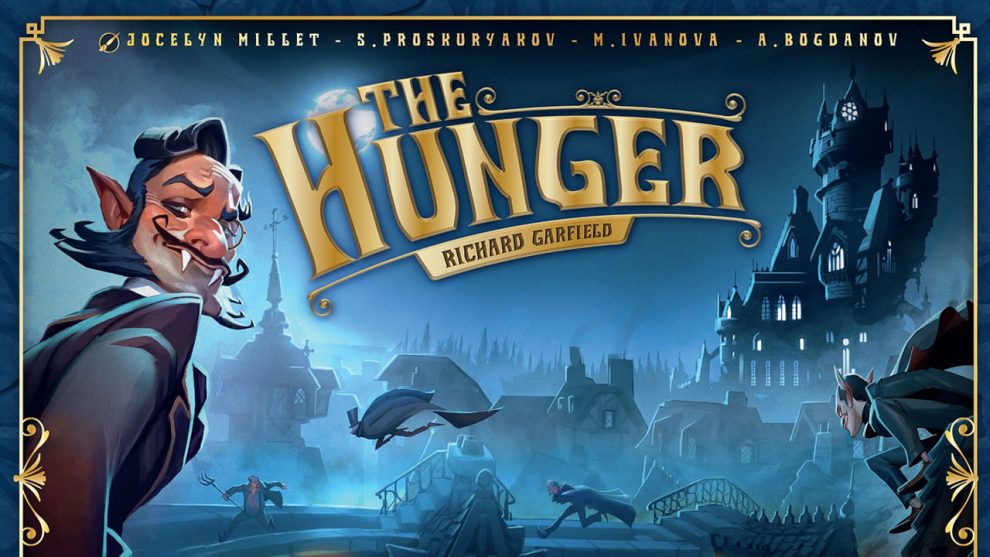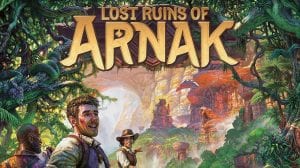Disclosure: Meeple Mountain received a free copy of this product in exchange for an honest, unbiased review. This review is not intended to be an endorsement.
Nestled in the valleys and forests of Unnamed Country, in the shadow of the stately Unnamed Mountain, lie several Unnamed villages bustling with people of all shapes and sizes. The love of family and respect for tradition are the very core of their personal beliefs. They’re a hearty folk with a strong work ethic, but always down for a good celebration. If asked, they’d describe themselves as helpful and friendly, always willing to lend a helping hand to their neighbors. One thing they’d never describe themselves as, however, is tasty.
But wrapped in luxury here in your castle nestled in the peaks of Unnamed Mountain, you know better. There’s something undeniable about the taste of these people. Their blood is like no other. Whether it’s genetic or something borne from their life of toil and camaraderie, you don’t know. All you know is that it’s…different somehow. And just thinking about it makes your mouth water. You’ve got The Hunger.
Objective
In The Hunger, designed by Richard Garfield (famous for his other designs such as Bunny Kingdom, KeyForge, King of Tokyo, and–you might have heard of it–Magic: the Gathering), the players are vampires venturing from their castle perch to feed their thirst in the villages below to earn as many victory points as they can before the sun rises. The more people each vampire devours, the slower that vampire moves. If they can’t make it back to the castle before daybreak, they’ll be reduced to a pile of ash.
The Hunger is a racing, deckbuilding, press-your-luck game of bloodsucking, card combo-ing, carnage. Each player begins the game with the same deck of cards and they’ll be using these cards, 3 per turn, in order to: move along the map, hunt humans, collect familiars that provide permanent game-breaking powers, pick up new secret missions and vampire powers, and race back to the castle before daylight… all in the quest to be the player with the most victory points when the game comes to a conclusion at the end of the 15th round. Only the best vampires will survive the night and, of those, only one will emerge victorious. Will it be you or will your long legacy come to an ignominious end as your soul burns away in the bright light of day?
Like a vampire bat’s perspective, this is the very highest level of overviews. If you’d like to get a ground level idea of how the game is played, keep on reading. Otherwise feel free to skip ahead to the Thoughts section to find out what I think about The Hunger.
Setup
There are two different modes of play, rookie and elder, and the setup will vary slightly depending on which you select. In general, rookie mode will make it easier on the players to survive, while elder mode takes off the training wheels. For the purposes of this review, I’m going to talk about elder mode.
Once the game is set up, it will look something like this:
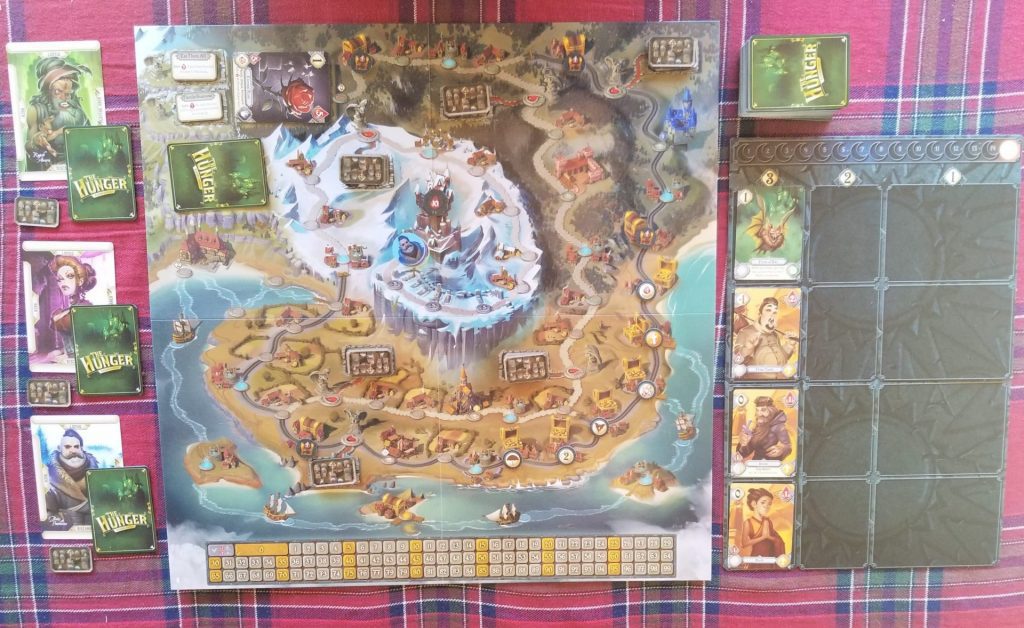
The game board will be laid out between the players with each player’s pawn stacked on top of the castle and their score markers set to 0. Different spaces on the board are seeded with different things: mission spaces will be seeded with face down mission tiles, the treasure spaces with treasure tokens, the labyrinth with the three Rose cards, the tavern with three face-down cards drawn from the deck of shuffled Hunt cards, and the castle with a stack of bonus tokens.
The remaining cards of the Hunt card deck are placed face down next to the Hunt track which will have a number of rows equal to the player count plus one. The leftmost column will be seeded with face-up cards drawn from the deck. Some of these cards may move into the middle column if they possess the ‘slow’ trait (more on this later).
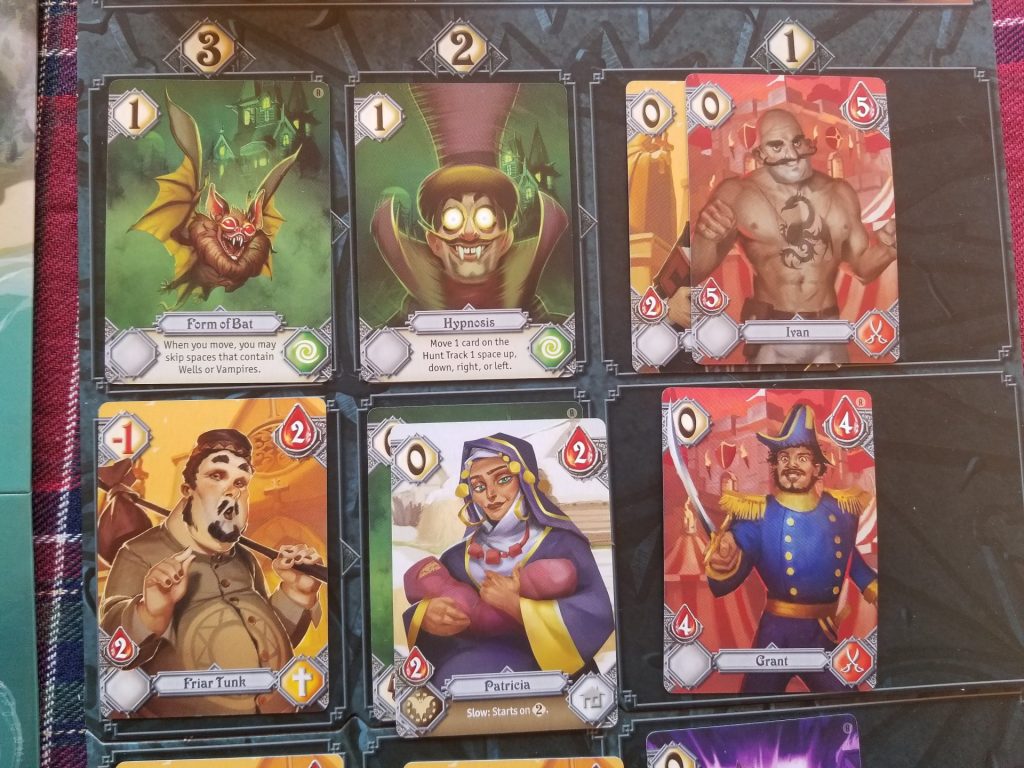
Aside from that, each player will have their player sheet along with the deck of starter cards associated with whichever character they have selected and 2 Mission tiles (of which they will select 1 to keep and 1 to return to the box). The 6 starter cards are shuffled and placed next to the Deck portion of their player board. Then they will each draw 3 cards and reveal them. The player who has the slowest total speed (the values in the top left corner added together) will become the start player with each subsequent player becoming second, third, etc. based on their total speed. Players will know their place in the turn order because the slowest person’s pawn will be on top of the stack, the fastest player’s pawn on the bottom, and the other players’ pawns in between in ascending order from top to bottom.
Then you’re ready to begin.
Sharpening Your Fangs
On a player’s turn, they will play all the cards from their hand into their playing area. This differs slightly from most other deckbuilding games where the cards are laid out and handled one at a time, so it takes a little bit of getting used to. It’s consistently the one aspect of The Hunger that I see new players struggle with. And while it may seem arbitrary, there is a good reason for it, which you will soon discover.
Once the players have laid out their cards, they will resolve any draw and/or discard effects on the cards. For instance, some cards may reward you for having a certain number of Humans in play. Some cards may allow you to discard cards in play to gain other benefits. Some may allow you to draw and play additional cards.

After you’ve handled your draw/discard effects, you will tally up your final speed. Your speed is essentially the number of action points that will be at your disposal for the remainder of the round. In addition to calculating your speed, you may have to apply the effects of some of your non-discarded cards. A Drunken Human, for instance, will bestow upon you the ‘confused’ status which will force you to immediately move 4 spaces away from the castle before you can even begin spending your speed! That’s not so bad early in the game where moving away from the castle is the general idea, but it can be a real kicker when you’re desperately racing back to the castle to avoid getting burned to a crisp.
Finally, you spend your speed in whatever manner you see fit and then end your turn, flipping your player pawn to its blank side to indicate that you’re done. Then the next player’s turn begins.
Out For a Quick Bite
On your turn, you can spend your speed to perform 2 possible actions: Moving and possibly triggering board effects depending on where your movement ends, and Hunting. Your first turn of the game will always be spent moving before doing anything else. This is not necessarily the case in future turns. In future turns, a vampire can always eschew moving (unless a card effect forces them to move) and opt to stay put and activate the board effect of whichever space they’re on (as long as they have at least 1 single movement left) and possibly even hunt.
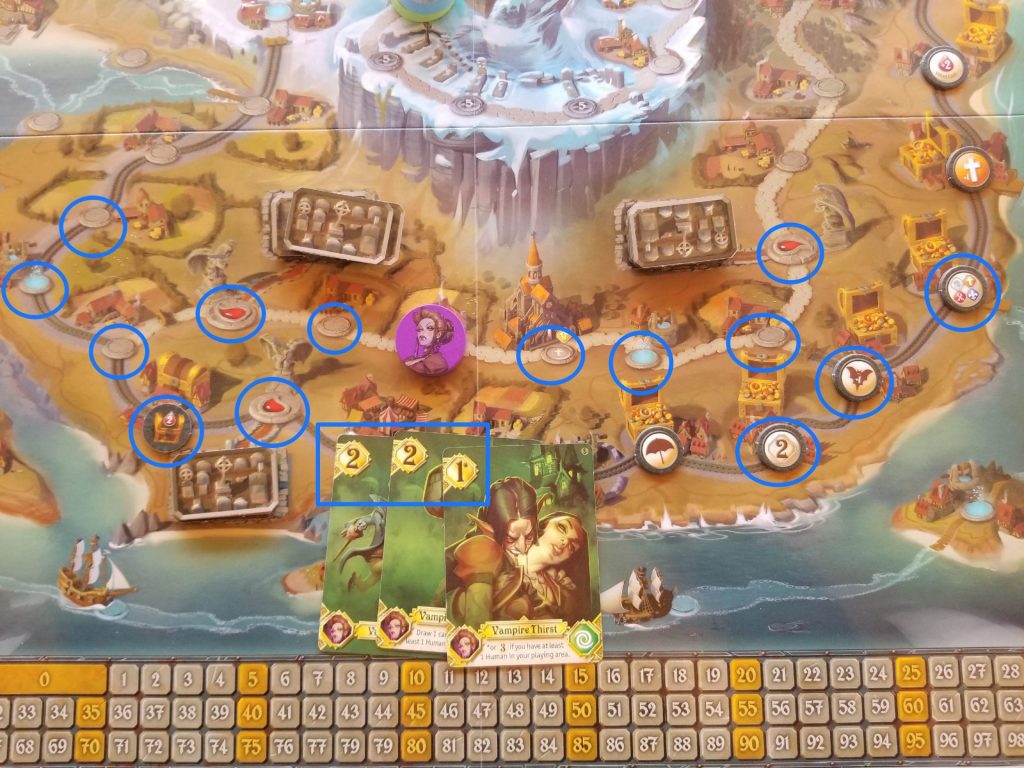
Moving is easy and can be done in any direction so long as a vampire never doubles back over the same space in the same turn. Simply move however many spaces you’d like and deduct that number from your total speed. For instance, if you have 5 total speed available, you may choose to move 2 spaces and save the remaining 3 speed for hunting. Or you may decide to cut your movement short.
Going For the Jugular
Once you’ve finished your movement, you may then hunt. There are 3 columns on the Hunt track and several rows. You will select a column to take cards from spending the required speed to do so (shown at the top of the column). Then you’ll select a single row and take all of the cards from where the chosen row and column intersect. Usually these cards will go directly into your discard pile after they have been scored. Some may have the ‘ready’ effect which means they can be placed in the discard pile or directly on top of your draw pile (your choice). Any Humans collected this way will typically score you immediate points (the number printed in the blood drop symbol—which denotes victory points) on the score track.
Typically, you are only allowed a single hunt per turn. However, if you end your movement on a Well, then you are allowed to hunt from the ‘1’ column an additional time (as long as you have the speed leftover to do so). There are also some familiars that will allow you to hunt an additional time. And while it might seem like a good idea to just park as close to the castle as you can, it’s worth mentioning that there are places you cannot hunt (in the castle, in the cemetery, and on the water) as well as regions of the map that give you bonuses for hunting there. Hunting in any of the villages on the mountain itself provides no bonus points. The next region, the plains, gives you an extra victory point for every Human you hunt. The forest, the furthest region from the castle, will give you an extra 2!
The Tastiest Game
In addition to the speed they may provide and the victory points you earn when you initially hunt them, once they’ve cycled through your deck and back into your hand Humans have some other important characteristics as well.
Some humans have unique characteristics that are shown at the bottom of the card, such as the aforementioned drunk person or the Human with the ‘slow’ trait, which come into play when they are in your playing area, or when they initially arrive on the Hunt track, or provide some kind of end-game scoring bonus based on specific criteria. Also, each Human has a specific type which is denoted by an icon in its lower right corner. This type is important for scoring some objectives at the end of the game (earn a point for each Human of a specific type, have more Humans of a specific type than any other player, etc.) and it is also important for the concept of digestion, the ability to remove a Human from your deck permanently. Digestion, however, can only be performed once per turn and only if you end your movement on the building whose type corresponds with the Human’s type.
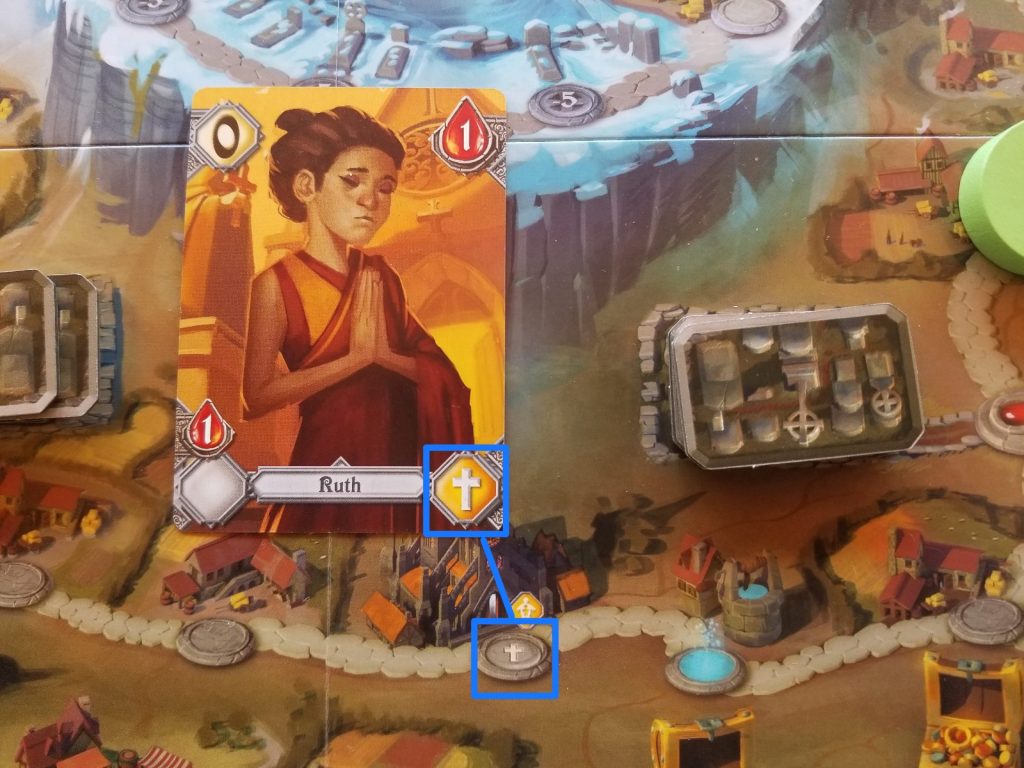
In addition to the Market, Church, Mansion, or Barracks (where digestion takes place), there are several other board effects:
– Ending your movement on a crypt allows you to obtain new Missions (hidden objectives that score victory points at the end of the game) and possibly replace any you may have that you’re not too keen on anymore.
– Ending your movement on the labyrinth allows you to expend 0 movement to collect one of the roses (which provide powerful, permanent effects as well as instant victory points).
– Ending your movement on a treasure chest allows you to collect the bonus token that’s there which immediately scores you victory points as well as a one-time use bonus of some kind (instant victory points, free movement, etc.).
Flying High and Weighed Down With Regret
Round 15 is the final round of the game. By this time, most of the vampires should have made their way back to the castle or at least be very close. If a vampire can’t make it back to at least the cemetery, they’ll be incinerated and be eliminated from the game. If a vampire makes it back to 1 of the 3 cemetery spaces before the castle, they will survive, but they’ll lose 5 points. If they return to the castle at any time during the game, they take the top bonus token which is instantly added to their score and they are stuck there for the remainder of the game. These bonus point tokens get smaller in value the later a vampire gets back to the castle, so it behooves a player to be the first to get there.
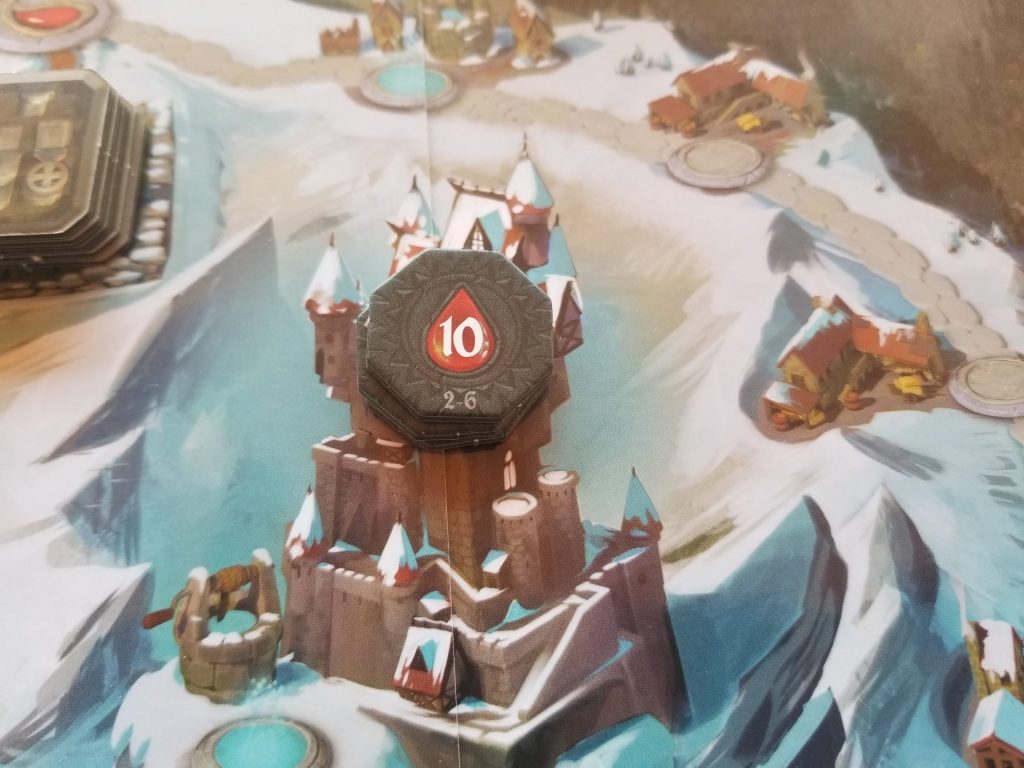
Provided you were one of the lucky vampires to make it back alive, you’ll add up any victory points earned from your Mission tiles, familiars, and Humans (there are a few familiars and Humans that reward end of game points) to any points you’ve scored over the course of the game. The player with the highest total wins. Ties are broken by whoever got back to the castle first or whoever is closest if nobody made it back.
Thoughts
I’ve never been a big fan of vampires. There. I said it. I came of age in the 90s when Anne Rice’s novel Interview With a Vampire was turned into a movie, launching a kind of Vampire Renaissance. Yeah, there may have been a lot of vampire literature out there before that time and, yes, Bram Stoker’s Dracula preceded the theatrical release of Interview by 2 years, but I remember the time as I lived it. It wasn’t until Interview that my friends actively began dressing up as and pretending to be vampires. It wasn’t until Interview that I started seeing vampires popping up everywhere I looked. Before Interview, vampires were relegated to classic horror, Sesame Street, and cereal boxes. Once the floodgates were opened and the market became oversaturated, anything that may have felt fresh about Interview soon didn’t.
By the time The Hunger arrived on the scene, I was all vampired out. If this had been a game designed by anyone other than Richard Garfield, I would have passed and been none the wiser. Being a long time Magic: the Gathering player and a KeyForge acolyte, I decided to take a flier on the game knowing that the end result could wind up with me doing a lot of exasperated eye rolling and feeling completely disengaged. Richard Garfield is a name that I trust and it was my fervent hope that he wouldn’t do me dirty.
He didn’t. The Hunger is an absolutely fantastic game.
The first game was a struggle as my wife and I were trying to wrap our heads around how all of the various pieces fit together. Needless to say, neither of us made it back to safety that game and we both met our untimely ends. It became apparent to us that in The Hunger, timing is everything. Wait too long to turn back and you won’t have the time to react to untimely negative trait draws. Turn back too soon and you’re leaving victory points on the table.
After our second or third game, my wife commented about how The Hunger was quickly becoming one of her favorite racing games. I found that comment interesting because I hadn’t considered The Hunger a racing game at all up until that point. In my mind, I was playing a tight, push-your-luck game. Other people I have played with have commented on what a good deck building game The Hunger is and I think this is what I like the most about this game. Everyone takes something different from the experience.
As differently as everyone may view the experience, there are some things everyone has agreed on like how much fun the game is. That isn’t in question. Every time I play the game, everyone is engaged from start to finish, although the added player count leads to you having to wait for a long time before you can take your next turn. This is particularly noticeable in later rounds when players have added enough cards to their deck to generate a lot of combos. While that is a slight drawback, the game definitely plays better at higher player counts.

There’s an aspect of the game I haven’t talked about yet that really comes into play as more players are added to the game. When players end their movement on the same space as other players, they can push that player’s pawn onto an adjacent space. The Hunt track doesn’t refill as soon as a card is removed for it, so the further back in turn order you are, the more constricted your options become when you get around to hunting. This leads to a lot of pushing and shoving as players jockey for that first player position. There’s also a lot of shoving towards the end of the game while players are trying their best to ensure their competitors get caught out in the sunlight.
Everyone also agrees that while pretty much everything makes sense from a thematic standpoint, the concept of a Human you’ve already hunted coming back to haunt you by giving you indigestion or whatever is a little weird. It’d be understandable to maybe become intoxicated upon initially ingesting a Drunken Human, but it doesn’t make sense for that same card to cause you to become intoxicated multiple times over the course of the game. It’s definitely a blemish on an otherwise untarnished thematic backdrop, albeit a small one. Aside from that, my only other complaint would be regarding the setup. It can be a bit of a bear, so I always recruit some of the other players to help me out to make it go by a little faster.
So, if a fast moving, deck building, sun racing, blood sucking, pole positioning, point scoring game about a group of vampires venturing down from their mountain home sounds like your cup of tea blood, definitely give The Hunger a try. I think you’ll be surprised by how much you’ll enjoy it. It’s certainly sunk its fangs into me.


